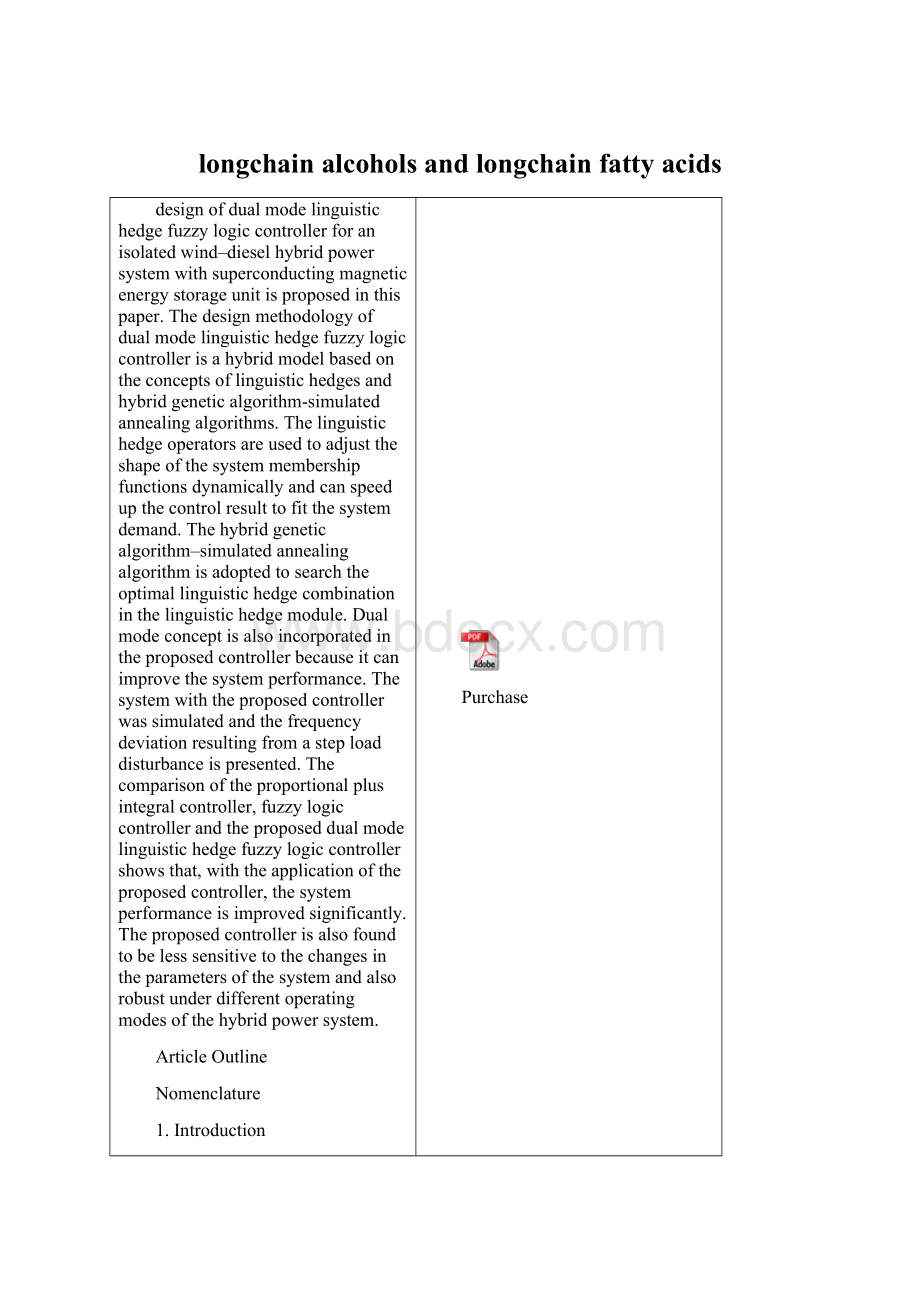longchain alcohols and longchain fatty acids.docx
《longchain alcohols and longchain fatty acids.docx》由会员分享,可在线阅读,更多相关《longchain alcohols and longchain fatty acids.docx(58页珍藏版)》请在冰豆网上搜索。

longchainalcoholsandlongchainfattyacids
designofdualmodelinguistichedgefuzzylogiccontrollerforanisolatedwind–dieselhybridpowersystemwithsuperconductingmagneticenergystorageunitisproposedinthispaper.Thedesignmethodologyofdualmodelinguistichedgefuzzylogiccontrollerisahybridmodelbasedontheconceptsoflinguistichedgesandhybridgeneticalgorithm-simulatedannealingalgorithms.Thelinguistichedgeoperatorsareusedtoadjusttheshapeofthesystemmembershipfunctionsdynamicallyandcanspeedupthecontrolresulttofitthesystemdemand.Thehybridgeneticalgorithm–simulatedannealingalgorithmisadoptedtosearchtheoptimallinguistichedgecombinationinthelinguistichedgemodule.Dualmodeconceptisalsoincorporatedintheproposedcontrollerbecauseitcanimprovethesystemperformance.Thesystemwiththeproposedcontrollerwassimulatedandthefrequencydeviationresultingfromasteploaddisturbanceispresented.Thecomparisonoftheproportionalplusintegralcontroller,fuzzylogiccontrollerandtheproposeddualmodelinguistichedgefuzzylogiccontrollershowsthat,withtheapplicationoftheproposedcontroller,thesystemperformanceisimprovedsignificantly.Theproposedcontrollerisalsofoundtobelesssensitivetothechangesintheparametersofthesystemandalsorobustunderdifferentoperatingmodesofthehybridpowersystem.
ArticleOutline
Nomenclature
1.Introduction
2.Developmentofmathematicalmodelofanisolatedwind–dieselhybridpowersystemwithSMESunit
2.1.Transferfunctionmodel
2.2.Continuous-timedynamicmodel
2.2.1.ModelofisolatedwindpowersysteminthehybridpowersystemwithSMESunit
2.2.2.ModelofdieselpowersysteminthehybridpowersystemwithSMESunit
2.2.3.ModeloftheSMESunitinthehybridpowersystem
2.2.4.Determinationofthecontinuous–timestatespacemodel
3.Outputfeedbackcontrolscheme
4.Designofproposeddualmodelinguistichedgefuzzylogiccontrollerwithoutputfeedback
5.Applicationofproposeddualmodelinguistichedgefuzzylogiccontrollerforanisolatedwind–dieselhybridpowersystemwithSMESunit
5.1.Developmentofmathematicalmodel
5.2.DesignofconventionalPIcontrollerandFLCwithoutputfeedback
5.3.DesignofproposedDMLHFLCwithoutputfeedback
5.4.Determinationofoptimallinguistichedgecombination
5.5.Simulationresultsandobservations
5.6.Performanceanalysisoftheproposedcontrollerunderparametervariation
5.7.PerformanceanalysisoftheproposedcontrollerundervariousoperatingmodesofthehybridpowersystemwithSMESunit
5.7.1.wind–dieselhybridpowersystemmode
5.7.2.WindpowersystemwithSMESunitmode
5.7.3.Windstandalonepowersystemmode
6.Conclusions
Acknowledgements
AppendixA.Appendix
A.1.Systemparameters
A.2.SMESunitdata
References
Purchase
58
Theeffectofactuatordynamicsonactivestructuralcontrolofoffshorewindturbines OriginalResearchArticle
EngineeringStructures,Volume33,Issue5,May2011,Pages1807-1816
GordonM.Stewart,MatthewA.Lackner
Closepreview | Relatedarticles | Relatedreferenceworkarticles
AbstractAbstract|Figures/TablesFigures/Tables|ReferencesReferences
Abstract
Whenimplementingactivestructuralcontrolinlargescalewindturbines,caremustbetakentoaccuratelymodelthedynamicsoftheactuatorinordertodeveloparobustcontrolsystem.Inthispaper,alimiteddegreeoffreedommodelisconstructed,andtheeffectsofbothactuatordynamicsandcontrol-structureinteractionareinvestigatedforanelectricmotor.Themodelisanalyzedinthefrequencydomaininordertohighlighttheseeffects.Theperformanceoftheactivecontrolmodelconsideringactuatordynamicsiscomparedtopreviousworkinwhichanidealactuatorwasused.Itisdemonstratedthatwhileloadingisreducedforcasesthatincludeamorerealisticactuatormodel,greatlyincreasedactuatorpowerconsumptionmakesneglectingcontrol-structureinteractionincontrollerdesignundesirable.Finally,theimpactofthemechanicaldesignoftheactuatoroncontrol-structureinteractionisanalyzed.Itisshownthatbychangingthegearratiooftheactuator,theeffectsofcontrol-structureinteractioncanbereduced.
ArticleOutline
1.Introduction
1.1.Previouswork
1.1.1.Structuralcontrol
1.1.2.Hybridmassdamperforoffshorewindturbines
1.1.3.Control-structureinteraction
1.2.Overviewofresearch
2.Simulationtoolsandmodels
3.Limiteddegree-of-freedommodel
4.Frequencydomainanalysis
4.1.EffectofgearratioonCSI
5.FAST-SCsimulation
5.1.Pseudo-passiveanalysis
5.2.HMDanlysis
6.Conclusionsandfuturework
Acknowledgements
Appendix.Appendix
References
Purchase
59
TheALICETPC,alarge3-dimensionaltrackingdevicewithfastreadoutforultra-highmultiplicityevents
NuclearInstrumentsandMethodsinPhysicsResearchSectionA:
Accelerators,Spectrometers,DetectorsandAssociatedEquipment,Volume622,Issue1,1October2010,Pages316-367
J.Alme,Y.Andres,H.Appelshäuser,S.Bablok,N.Bialas,R.Bolgen,U.Bonnes,R.Bramm,P.Braun-Munzinger,R.Campagnolo,P.Christiansen,A.Dobrin,C.Engster,D.Fehlker,Y.Foka,U.Frankenfeld,J.J.Gaardhøje,C.Garabatos,P.Glässel,C.GonzalezGutierrez,etal.
Closepreview |
PDF(8818K) | Relatedarticles | Relatedreferenceworkarticles SponsoredArticle
AbstractAbstract|Figures/TablesFigures/Tables|ReferencesReferences
Abstract
Thedesign,construction,andcommissioningoftheALICETime-ProjectionChamber(TPC)isdescribed.Itisthemaindeviceforpatternrecognition,tracking,andidentificationofchargedparticlesintheALICEexperimentattheCERNLHC.TheTPCiscylindricalinshapewithavolumecloseto90 m3andisoperatedina0.5 Tsolenoidalmagneticfieldparalleltoitsaxis.
InthispaperwedescribeindetailthedesignconsiderationsforthisdetectorforoperationintheextrememultiplicityenvironmentofcentralPb–PbcollisionsatLHCenergy.Theimplementationoftheresultingrequirementsintohardware(fieldcage,read-outchambers,electronics),infrastructure(gasandcoolingsystem,laser-calibrationsystem),andsoftwareledtomanytechnicalinnovationswhicharedescribedalongwithapresentationofallthemajorcomponentsofthedetector,ascurrentlyrealized.Wealsoreportontheperformanceachievedaftercompletionofthefirstroundofstand-alonecalibrationrunsanddemonstrateresultsclosetothosespecifiedintheTPCTechnicalDesignReport.
ArticleOutline
1.Introduction
2.Fieldcage
2.1.Vessels
2.2.Centralelectrode
2.3.Rods
2.3.1.Resistorrods
2.3.2.High-voltagecablerod
2.3.3.Laserrods
2.3.4.Gasrods
2.4.Strips
2.5.Skirts
2.6.Endplates
2.7.I-bars
3.Readoutchambers
3.1.Designconsiderations
3.2.Mechanicalstructure
3.2.1.Wires
3.2.2.Wireplanes
3.2.3.Anode-wiregrid
3.2.4.Cathode-wiregrid
3.2.5.Gating-wiregrid
3.2.6.Coverandedgegeometry
3.2.7.Padplane,connectorsandflexiblecables
3.2.8.Padplanecapacitancemeasurements
3.2.9.Al-body
3.3.Testswithprototypechambers
3.3.1.Descriptionofproductionsteps
3.3.2.Qualityassuranceandtests
3.4.Chambermountingandpre-commissioning
4.Front-endelectronicsandreadout
4.1.Generalspecifications
4.1.1.Systemoverview
4.2.PASA
4.3.ALTRO
4.3.1.Circuitdescription
4.3.2.Physicalimplementation
4.4.Front-endcard(FEC)
4.4.1.Circuitdescription
4.4.2.Physicalimplementation
4.5.RCU
4.5.1.RCUmotherboard
4.5.2.DCSboard
4.6.Triggersubsystem
4.7.Radiationtolerance
4.7.1.SEU
4.7.2.SEL
4.8.Testingprocedure
5.Coolingandtemperaturestabilizationsystem
5.1.Overview
5.2.Thenecessityforuniformtemperatures
5.2.1.Heatloadandcomputationalfluiddynamicscalculations
5.3.Principleofunderpressurecooling
5.4.TPCcoolingplants
5.4.1.Coolingcircuits
5.5.Coolingstrategy
5.6.Commissioningofthecoolingsystem
5.6.1.Testwithmock-upsectors
5.6.2.Startupproceduresandoperation
5.6.3.Cavitationproblem
5.7.Temperaturemonitoringsystem
5.7.1.Temperatureprofileandhomogenization
6.Gasandgassystem
6.1.Gaschoice
6.1.1.Implicationsofthegaschoice
6.2.Descriptionofthegassystem
6.2.1.Configuration
6.2.2.On-detectordistribution
6.2.3.Filling
6.2.4.Running
6.2.5.Back-upsystem
6.2.6.Analysis
7.Lasersystem
7.1.Requirements
7.2.Systemoverview
7.3.Opticalsystem
7.3.1.UVlasers
7.3.2.Laserbeamtransportsystem
7.3.3.Micromirrorsandlaserrods
7.4.Laserbeamcharacteristicsandalignment
7.4.1.Narrowbeamcharacteristics
7.4.2.Narrowbeamlayout
7.4.3.Spatialprecisionandstability
7.4.4.Constructionandsurveys
7.4.5.Onlineandofflinealignment
7.5.Operationalaspects
7.5.1.Beammonitoringandsteering
7.5.2.Triggerandsynchronization
8.Infrastructureandservices
8.1.MovingtheTPC
8.2.Servicesupportwheel
8.3.Low-voltagedistribution
8.4.ChamberHVsystem
8.5.Gatepulser
8.6.Calibrationpulser
9.Detectorcontrolsystem(DCS)
9.1.Overview
9.1.1.Hardwarearchitecture
9.1.2.Softwarearchitecture
9.1.3.Systemimplementation
9.1.4.Interfacestodevices
9.1.5.Interlock
9.2.Electronicscontrol
9.2.1.Front-endmonitoring
9.2.2.Front-endconfigurationandcontrol
9.3.Interfacestoexperimentcontrolandoffline
10.Commissioningandcalibration
10.1.Calibrationrequirements
10.2.Commissioning
10.2.1.Commissioningphases
10.2.2.Datasets
10.3.Electronicscalibration
10.3.1.Pedestalandnoisedetermination
10.3.2.Tail-cancellationfilterparameterextraction
10.4.Ga